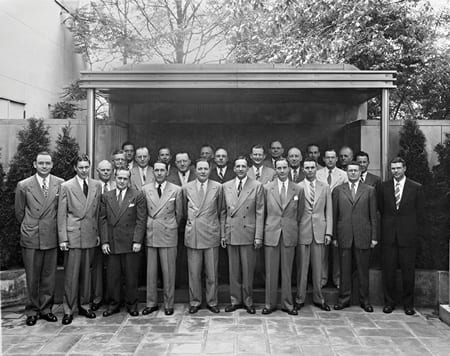 Welcome to Thursday Trivia where we offer up a historical automotive trivia question and you try and solve it before seeing the answer after the jump. It’s like a history test, with cars! This week’s question: Who were the “Whiz Kids” of 1946 and what importance did they have? If you think you know the answer, make the jump and see if you are right. WWII did more to impact the world’s auto industry than probably any other event in its history. It of course caused the cessation of production during hostilities as car makers turned their efforts to war production. And when the dust had settled and post-war civilian production resumed, not all the players were able to get back on the field. The War didn’t only have a deleterious effect on the automotive market, there were also technological advancements that had peace-time uses. Things like disc brakes and the Jeep transferred from the War effort directly to civilian use. Another thing that came out of the war was a concept of decision making based on numerical modeling, which was led by the army’s division of Statistical Control. Headed by Charles “Tex” Thornton, Stat Control would bring order to the Military’s planning through statistical analysis that would replace the guess work and gut instinct that was driving much of the decision process at the time. One of the group’s successes was proving statistically that the new B29 bomber would be a more efficient bomb delivery mechanism to Japan than the b-17s and B-24s that were being transitioned from Europe. At the end of the war the group of 10 statisticians and analyzers had saved the U.S. Military millions of dollars and likely countless lives. Saving the Ford Motor Company was the paramount goal of Henry Ford II as he took control of the company following the end of hostilities and his grandfather’s decline and death. In 1946 the company lost $60 million dollars due to poor management and a lack of a long vision on how to position Ford for the post-war world.
Welcome to Thursday Trivia where we offer up a historical automotive trivia question and you try and solve it before seeing the answer after the jump. It’s like a history test, with cars! This week’s question: Who were the “Whiz Kids” of 1946 and what importance did they have? If you think you know the answer, make the jump and see if you are right. WWII did more to impact the world’s auto industry than probably any other event in its history. It of course caused the cessation of production during hostilities as car makers turned their efforts to war production. And when the dust had settled and post-war civilian production resumed, not all the players were able to get back on the field. The War didn’t only have a deleterious effect on the automotive market, there were also technological advancements that had peace-time uses. Things like disc brakes and the Jeep transferred from the War effort directly to civilian use. Another thing that came out of the war was a concept of decision making based on numerical modeling, which was led by the army’s division of Statistical Control. Headed by Charles “Tex” Thornton, Stat Control would bring order to the Military’s planning through statistical analysis that would replace the guess work and gut instinct that was driving much of the decision process at the time. One of the group’s successes was proving statistically that the new B29 bomber would be a more efficient bomb delivery mechanism to Japan than the b-17s and B-24s that were being transitioned from Europe. At the end of the war the group of 10 statisticians and analyzers had saved the U.S. Military millions of dollars and likely countless lives. Saving the Ford Motor Company was the paramount goal of Henry Ford II as he took control of the company following the end of hostilities and his grandfather’s decline and death. In 1946 the company lost $60 million dollars due to poor management and a lack of a long vision on how to position Ford for the post-war world. 
After the war ended in 1945, the ten Air Force officers who ran Stat Control sold themselves as a group to Henry Ford II. They met with Henry and promised to bring statistical rigor to Ford using the techniques they had developed. They had a huge impact at Ford in the 1950s and 1960s, creating a dynasty and legacy that has influenced almost every American corporation and MBA student ever since.
The group is today known as The Whiz Kids for the statistical rigor they brought to both the Military and industry. The financial housecleaning they undertook at Ford brought the company back from the brink and provided the capital that produced the 1949 Ford. That was the car that many claimed “saved the company.” Along with Tex Thornton, many of the other names of the Whiz Kids are famous for other endeavors. Robert McNamara would become President of Ford in 1960, but would only serve in that position for little more than a year as he was shortly tapped by Jack Kennedy for Secretary of the Defense. Other notable members included R.J.Miller who would also have a stint as Ford CEO, and J. Edward Lundy who served as the company’s CFO from 1967 through ’79. Of course while touted as saviors in both military and Ford’s histories, the Whiz Kids did create a corporate culture that is foremost financially-driven and gave rise to the nefarious and shadowy groups known as the “Bean Counters” who would in later years deny us any number of cool and fun toys simply because they didn’t make financial sense. Image: DBusiness Magazine


Leave a Reply